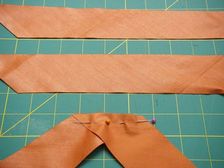Making Bias Strips
The beauty of making bias strips is that you are able to use similar or co-ordinating fabric to that of the cushion or cover.
This can also be bought from shops. The weight of the fabric used should be the same for both.
These are used for covering cord to make a piped edge cushion or for a replacement cushion cover.
Piping is used in upholstery to give strength to cushion and for decorative touches. The cushions on a chair or a settee could have this around the edges of the seats.
The fabric used for piping can be cut on the bias but also can be used on the straight grain. Sometimes depending on the type of fabric used if it is too stretchy the piping can look uneven or wavy.
Bias strips are best if the piping is to be placed on curves as this allows more stretch.
Steps to making bias strips for cording
Cutting the Strips

The material should be cut on the bias or diagonal fold in strips and wide enough to cover the cord and to give a good allowance to be sewn into the seam.
Sewing Strips together
With right sides of the material together, these strips are sewn at right angles.


These will give a continuous length of material that is slightly stretchy and try to make sure the width is kept straight.


Inserting the cord
Wrap the strip over the cord right sides facing out.
Making sure the edges meet and sew. This can be done under the seam allowance and just to keep the cord in place.
If sewing too close to the cord you will need to use the piping foot if you have one or the zip foot to your machine.
If you sew too close to the cord at this stage then the stitching may be visible when you stitch it between the front and the back of the cushion.
It may help to sew the seam further away from the cord to keep it in place ready for inserting into the cushion.

This strip would then be place on the seam line between the front and back pieces of fabric.
On the wrong side on the cushion the strip would need to be snipped at intervals to allow some give to turn corners.
When the piping has gone all around the seam then the edges have to be cut so they butt right up to each other. The bias strip is then overlapped slightly to hold it in place.
You have now made a bias casing for your piped edge cushion. This can be gathered to give a ruffled look.
Affiliate offers
Please take care with any soft furnishing that it does not come into contact with any heat source.
If you have found an error on this page or want some more information on sewing cushions.
Please contact me . Thank you



New! Comments
Have your say about what you just read! Leave me a comment in the box below.